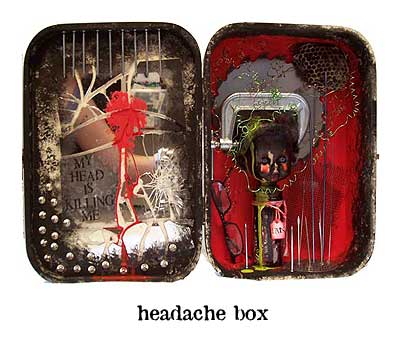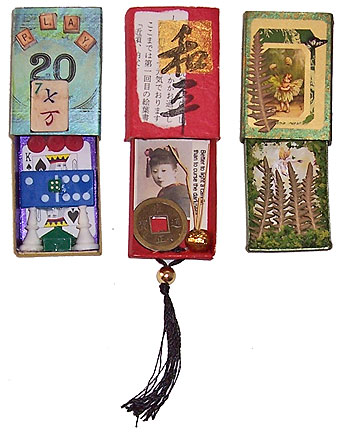 I keep a folder of email requests folks have sent in, and while looking through it this morning, I noticed quite a few of them asking questions about making shrines. Since this topic is at the front of my brain right now, with the year-long birthday shrine project, plus several pieces of personal art in the works, I thought it might be time to throw a few ideas down on paper.
I keep a folder of email requests folks have sent in, and while looking through it this morning, I noticed quite a few of them asking questions about making shrines. Since this topic is at the front of my brain right now, with the year-long birthday shrine project, plus several pieces of personal art in the works, I thought it might be time to throw a few ideas down on paper.
Shrines are a tough subject for many artists, because they are incredibly personal. A couple of years back, I ran a Yahoo group for shrine makers—it was one of the quietest groups I’ve ever experienced. There just wasn’t much conversation, either about thought process or technique. After six months or so, I closed the group, realizing that shrine making was so individual and personal to each artist that there just wasn’t much common ground for us to discuss. We were there because we built shrines or were interested in building shrines—but the process each of us goes through to get to a finished piece was so difficult to put into words, there just wasn’t anything to talk about.
So, here’s my best description of my process, in general terms. Know that this applies to me, and my work, and may be a complete disaster as a model for your own method of working. If you’re already making shrines, and do it differently—don’t change anything. If you want to make shrines, and find this process doesn’t work for you—develop one that makes sense for your own inner rhythym.
Let’s start with my vague definition of a shrine. Most people immediately connect that word with something either religious or contemplative. I’m not an extremely religious person, nor do I consider myself a particularly deep thinker, so in my work, those things don’t usually come into play. For me, a shrine is a self-contained expression of a single thought or theme. That’s a pretty broad definition that leaves the door open for a variety of interpretations.
I usually start a shrine with a single thought. It might be a general theme—nature is one I seem to address over and over again. It might be something very specific—I recently did a shrine to someone’s wedding day. It might be an image—my Headache Box started out with a vision of a clamped baby doll head, and grew from there.
Once I have my jumping off point, I start assembling pieces that might be used in this particular shrine. Pretty early on comes the choice of container, since this usually dictates the size and shape of the contents. I like found containers better than built ones—so, rather than build myself a wood box, I’ll go find one that’s the right size and shape. I do generally lean toward containers with some sort of lid, because I tend to like surprises. Many of my shrines look very different inside than they do on the outside—a prime example of this is Don’t Judge a Book By It’s Cover, which hangs on my living room wall.
 With a theme and a container chosen, I really focus on things that flesh out my theme. Using the Headache Box as an example, I looked for things that said pain, or that would convey the idea of hurt. This is the really personal part—what says pain to me may not say pain to anyone else. Sharp, pointy things or the color red might be obvious, but the thought process behind a hornet’s nest or broken mirrors may not be. This part becomes more complicated as we grow as artists, and start developing our own personal symbolism. I tend to blot out any thoughts about what people might think something means, and go on instinct—so, I don’t really care whether broken mirrors mean pain to you, I just care that the broken mirrors felt right to me as I was assembling the Headache Box, and I never once considered setting them aside in favor of something else.
With a theme and a container chosen, I really focus on things that flesh out my theme. Using the Headache Box as an example, I looked for things that said pain, or that would convey the idea of hurt. This is the really personal part—what says pain to me may not say pain to anyone else. Sharp, pointy things or the color red might be obvious, but the thought process behind a hornet’s nest or broken mirrors may not be. This part becomes more complicated as we grow as artists, and start developing our own personal symbolism. I tend to blot out any thoughts about what people might think something means, and go on instinct—so, I don’t really care whether broken mirrors mean pain to you, I just care that the broken mirrors felt right to me as I was assembling the Headache Box, and I never once considered setting them aside in favor of something else.
My shrines tend to be pretty packed with stuff. I build a little bit at a time—so, first the major elements are arranged and glued down, and then smaller, less important items are glued around them. I usually keep adding and gluing until the piece feels full, and apply the same weird compositional rules that I do with my collage pieces. I know I’m done when I try to add another piece half a dozen times, and it just seems to throw everything off. Often, I’ll step back from a piece, and feel that it needs something right here—this exact spot is missing something that completes the composition. I’ll generally work that spot forever until I find the right thing to fill it. This is 20 or so years of experience kicking in—my eye is telling me that there’s a dead spot in my composition, and I focusing attention on emptiness rather than the focal point.
OK, enough with the art school stuff—if you want to learn more about composition and leading people’s eyes around on a leash, there are plenty of books on the subject. I won’t attempt to conquer that monster here.
About halfway through the construction process, I usually start thinking about display. How will this shrine be shown once it’s finished? I split evenly between displaying pieces on a tabletop, which requires no extra finishing, and displaying them on the wall, which requires some thought about hanging hardware. Very often, it’s simpler to make this choice before you start filling your container, but sadly, I can’t train myself to do that. If I could just make myself add a hanger to the back of every box before I start, my life would be easier.
That’s all I can think of today. I’m sure I have more to say on this topic—enough that it will probably turn into a book at some point. In the meantime, the majority of my shrines, including the monthly installments from the birthday shrine project, can be found in the galleries.




